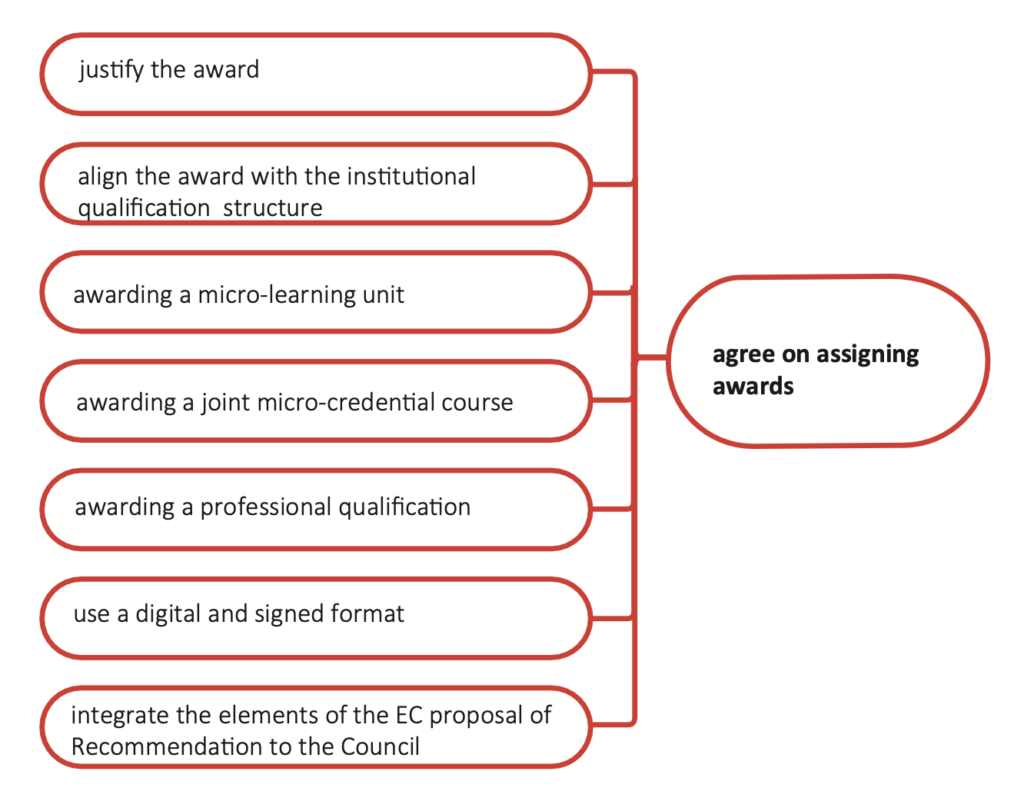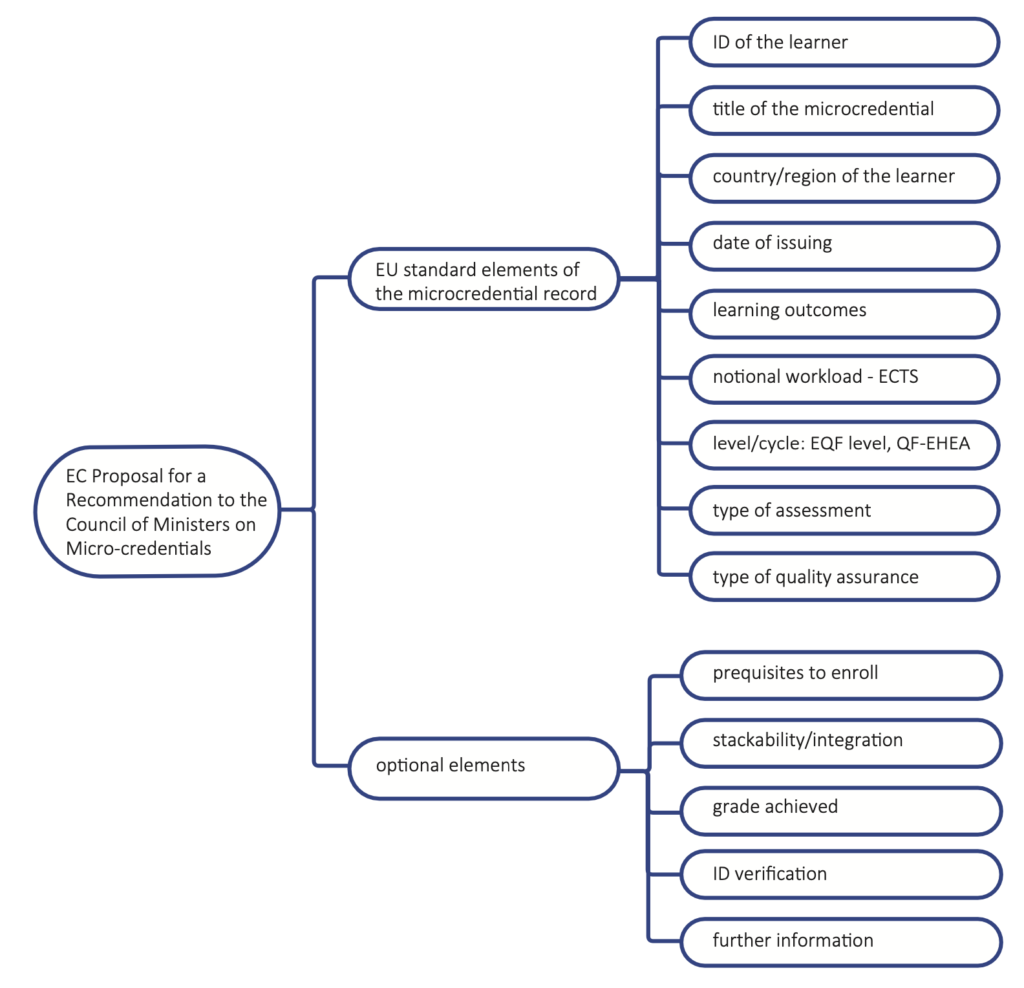
| The partnership must agree on a joint award for the joint micro-credential course. Successive decisions must be made; |
| Justify the award; |
| Align the award with the institutional qualification structure; |
| Awarding a micro-learning unit; |
| Awarding a joint micro-credential course; |
| Awarding a professional qualification; |
| Use a digital and signed format; |
| Integrate the elements of the EC proposal of Recommendation to the Council |
Justify the awards
Justify why the joint micro-credential course should lead to academic recognition by the partner universities and which joint award should be delivered. Take into account the content, the EQF level, the volume of the course and the possible stackability to a programme.
Also seek professional recognition from external stakeholders, such as professional organizations and employers, so that learners can valorise their micro-credential award for professional development credits or accreditation by professional bodies (e.g. related to professions in psychology, IT, medicine/healthcare, accountancy, education, business sector).
Align the award with the institutional qualification structures
Participating institutions are likely to have very different institutional qualification structures for continuing and professional development, as can be seen from the study guides. These structures are adopted autonomously by institutions and possibly align with national and evolving European frameworks.
Partners should agree on a common award for the joint micro-credential course, as far as possible in line with the formal requirements of each institution. This calls for careful discussion.
Not all universities have developed a consistent qualification structure, and neither have governments. In fact, many institutional qualification structures are under development and in most cases not yet stable (see eBook on micro-credential programmes).
Institutional qualification structures might converge to the following characteristics and changes:
- a microlearning unit has a learning volume of less than 1 ECTS and is therefore smaller than a micro-credential. No credit award can be awarded, but it can possibly be awarded with a badge (of attendance participation or completion). The course can serve as a stand-alone unit (for example in corporate training) or as a unit in a credited course;
- a micro-credential course provides a reliable and valid assessment for which transferable ECTS points are awarded, in most higher education institutions more than 1 ECTS. The course can serve as a stand-alone offering (for example in corporate training) and possibly can be stackable to a broader educational programme;
- a CMF micro-credential programme is delivered as a coherent track of courses with a total volume of 4-6 ECTS, which is awarded with a CMF micro-credential qualification. This qualification can be stacked into a broader programme (European MOOC Consortium, 2018).
- A microdegree is delivered as a micro-credential programme of 20-40 ECTS, which is awarded with a microdegree qualification. Many existing programmes in higher education would meet the criteria for micro-credential programmes with this volume of learning.
- A degree is provided in the form of a bachelor’s or master’s degree (180, rep.60/90/120 ECTS). This degree qualification may be awarded following a modular series of micro-credential qualifications, supplemented by a thesis.
| From learning unit to degree programme | Volume (ECTS) | Level | Award |
| learning unit/micro-learning | Less than 1 ECTS | undergraduate EQF level 5, 6 postgraduate EQF level 7,8 | a badge/proof of attendance (can be part of a course or stackable to a course) |
| a single course a micro-credential course a single MOOC with credits | Number of ECTS credits awarded to the course | undergraduate EQF level 5, 6 postgraduate EQF level 7,8 | ECTS course credits (stackable to a programme) |
| CMF- micro-credential programme MOOC pathway | 4-6 ECTS | undergraduate EQF level 5, 6 postgraduate EQF level 7,8 | CMF micro-credential gradeo (stackable in a micro- credential programme or a degree programme) |
| micro-credential programme Micro-degree programme MOOC-based programme | 20-40 ECTS | undergraduate EQF level 5, 6 postgraduate EQF level 7,8 | under/postgraduate certificate microdegree specialisation certificate expert certificate certified professional programme focus diploma MicroMaster nanodegree diploma …. (stackable to a degree) |
| degree programme (bachelor/ master/doctorate) | 180 ECTS 60-90-120 ECTS 240 (180) ECTS | undergraduate EQF level 5, 6 postgraduate EQF level 7,8 | short cycle graduate bachelor/master degree doctorate degree |
Layers or exit points in this framework are defined based on the learning volume and the EQF qualification levels. An extra layer with a volume of 10-20 ECTS points is probably needed, as experienced in practice. Layers or exit points with a higher learning volume may also be suitable, e.g. for certain undergraduate and postgraduate programmes, depending on the overall qualification structure adopted by the institution. In the definition of this framework, the ability of learners to combine learning and working should be of prime importance.
Award a professional qualification
Micro-credential courses are sometimes co-created, endorsed or accredited by a professional organisation, business sector or public service (health care, education,…). These organizations recognize these courses in their own continuing professional development framework. In this way, micro-credential courses can sometimes be financed by the sector
or recognized for a personal learning account. In some cases, they will issue a specific professional credit in addition to the academic award of the university partnership.
Use a digital and signed format
The course should be awarded in a digital and signed format, for example, the European Digital Credentials (EDC) (Europass, 2022; ECCOE, 2022).
European Digital Credentials for Learning include diplomas, transcripts of records and a wide variety of other types of certificates of learning achievement. They are multilingual and signed with a unique electronic seal (that is the digital equivalent of an institution’s rubber stamp). This allows education and training institutions to easily authenticate, vali-
date and recognise credentials of any size, shape or form.
As described in Europass, European Digital Credentials for Learning can describe and certify:
- qualifications (e.g. professional certificates, university diplomas and other learning achievements);
- activities (e.g. participation in classes and non-formal learning events);
- assessments (e.g. transcripts of records), and
- entitlements (e.g. right to enroll in learning opportunities, or to undertake an occupation.
Integrate the elements of the proposal of the European Commission
The development of micro-credentials in a lifelong learning perspective is now a top priority of the European Commission. In the context of the European Education Area and the European Digital Education Plan, the European Commission recently issued a Proposal for a Recommendation to the Council of Ministers on Micro-credentials (European Commission, 2021b), which is expected to be implemented by Member States in 2025, recognizing
micro-credentials as qualifications for continuing education and professional development in the European Higher Education Area (the Bologna Process). See definitions in the first section on the concept of micro-credentials in this eBook.
These elements are already included in the Common Microcredential Framework (see detailed description in the eBook on joint Micro-credential Programmes) and are required to ensure that all qualification levels of microcredentials (Table 1) are readable by academia and employers.
Member States are requested to implement this Recommendation as soon as possible and submit a plan by (insert date 12 months after adoption by Council) setting out the corresponding measures to be taken at national level to support the achievement of the objectives of the Recommendation by 2025.

In this discussion, it is important that universities work together in dialogue with national governments, other stakeholders, and the EU to develop a qualification framework for continuing education and professional development
next chapter: Determine formative and summative assessment approaches
previous chapter: Design a microlearning unit
back to overview: Models and guidelines for the design and development of
joint micro-credential courses and microlearning units in higher education
